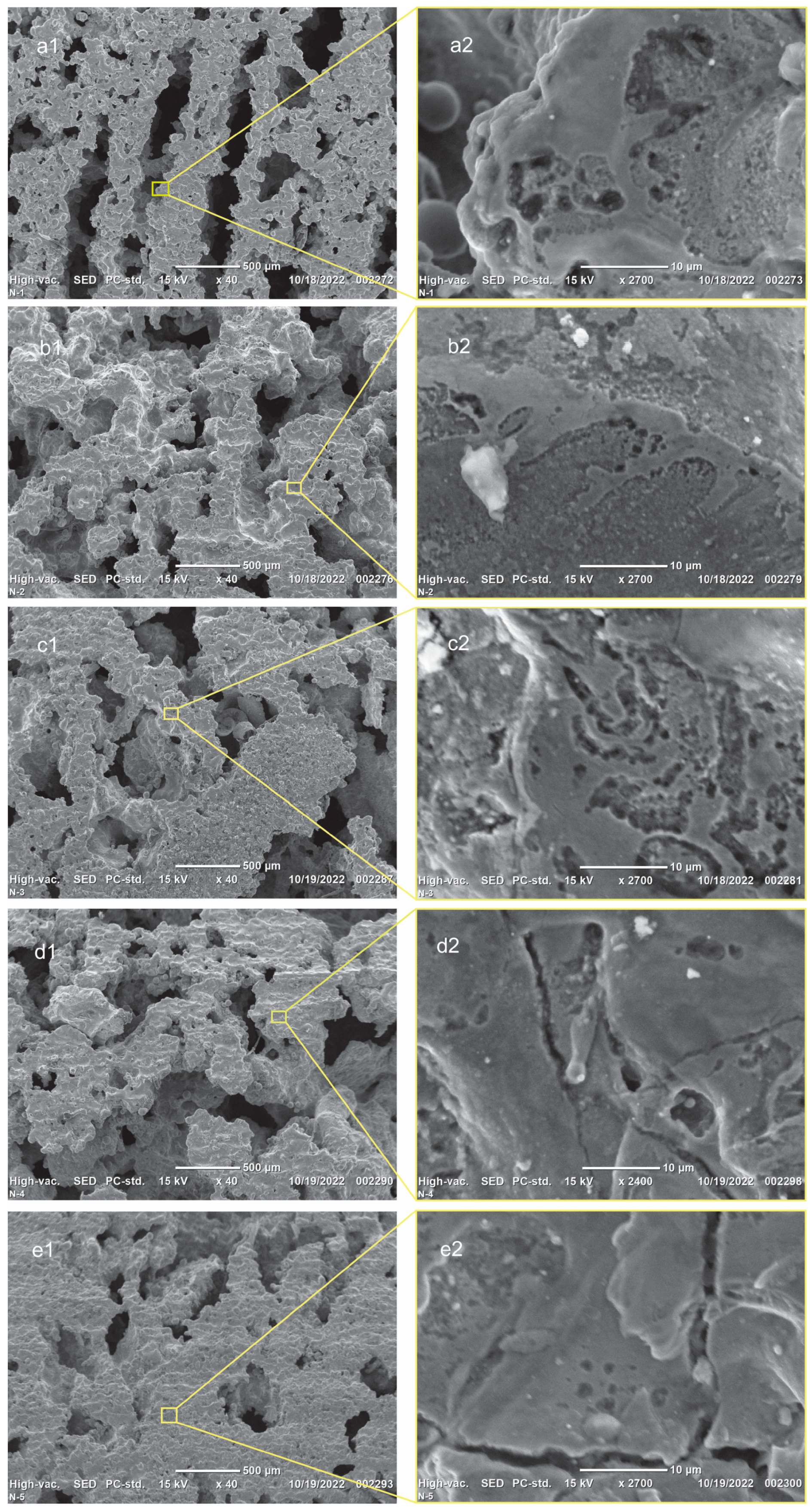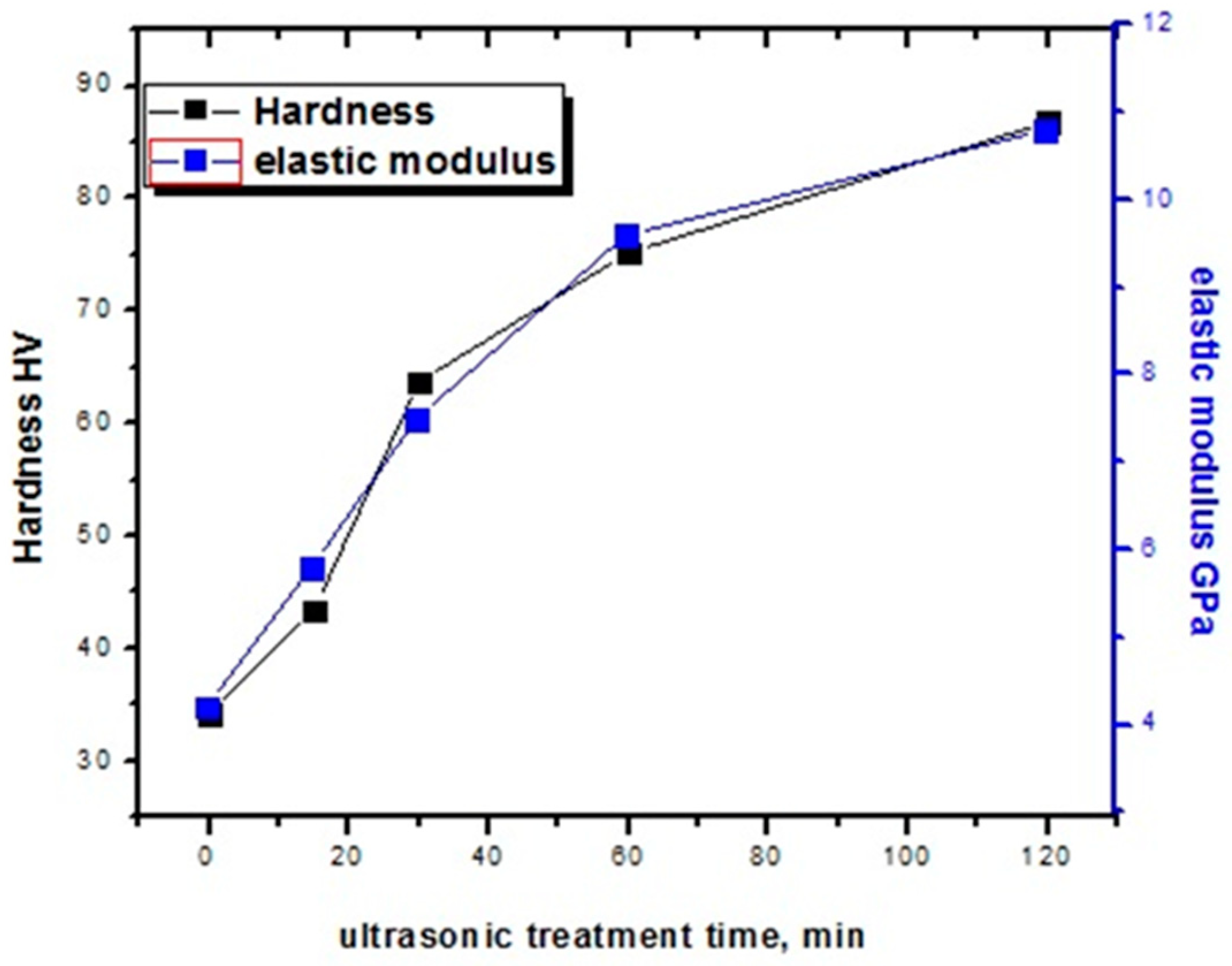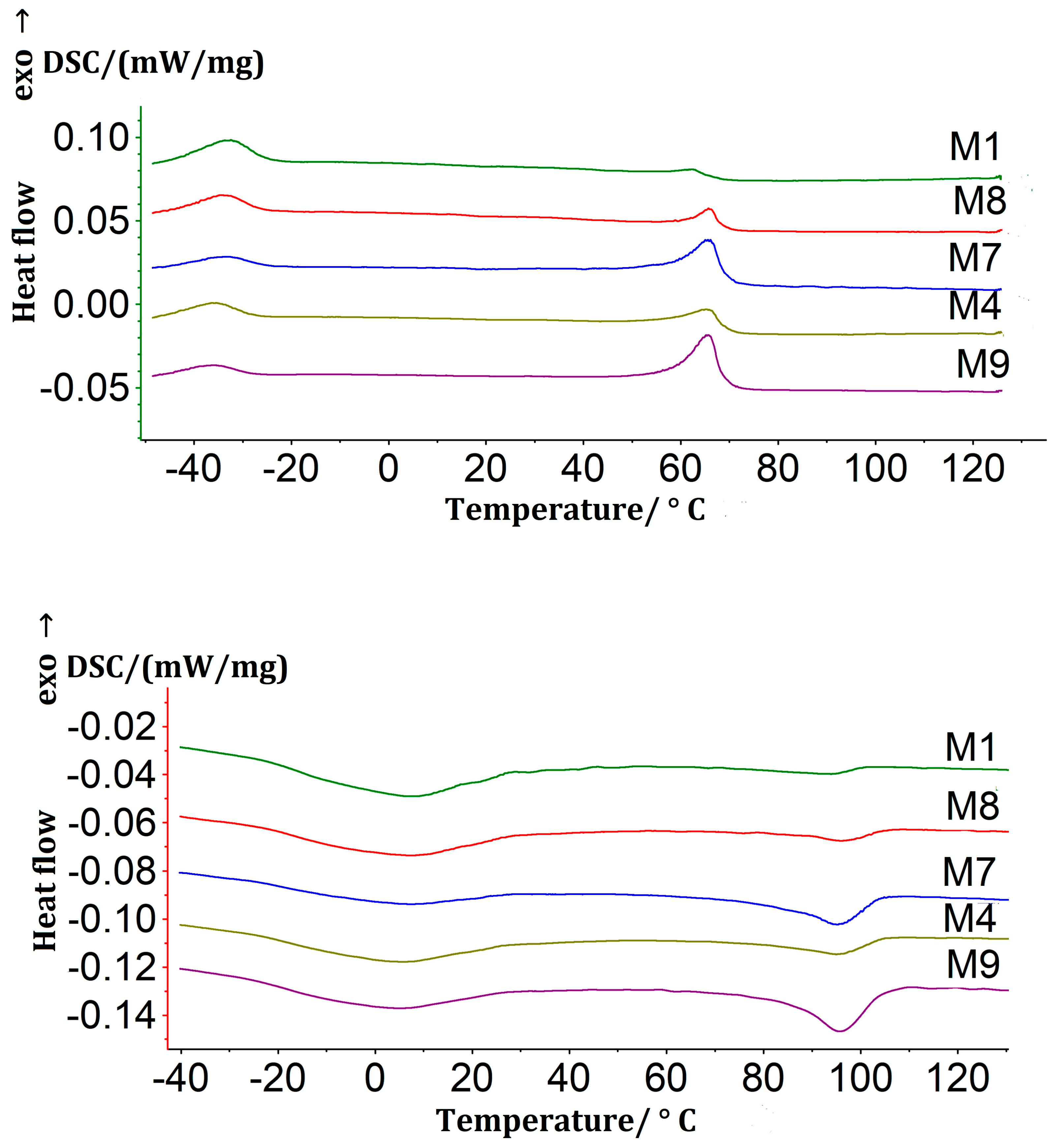The Influence of Ultrasonic Activation on Microstructure, Phase Transformation and Mechanical Properties of Porous Ni-Ti Shape Memory Alloys via Self-Propagating High-Temperature Synthesis
Abstract
:1. Introduction
2. Materials and Methods
3. Results and Discussion
3.1. The Porosity of the Ni-Ti SMA
3.2. Microstructure
3.3. Mechanical Properties
3.4. Phase Transformation
4. Conclusions
- From the point of view of the microstructure, the shape of the pores of the sample not activated via ultrasound sample was uniformly channel-shaped with an average width of about 250 µm and a length of about 1000 µm. In the samples treated with ultrasound, structural changes occurred, the pore size became larger (500–1000 µm), and the shape became mostly round.
- The main matrix Ni-Ti phase and precipitates Ti and Ni-Ti2 are formed.
- The phase transformation temperature of the Ni-Ti shape memory alloy is almost unchanged under the influence of ultrasonic treatment.
- The results of the analysis of the mechanical properties of the alloy show that with an increase in the time of ultrasonic treatment, the hardness and elasticity increase. The hardness of the sample without ultrasonic treatment is 34.1 HB, whereas the sample treated for 120 min is 86.8 HB, and the elastic range is 4.2–10.8 GPa.
Author Contributions
Funding
Institutional Review Board Statement
Informed Consent Statement
Data Availability Statement
Acknowledgments
Conflicts of Interest
References
- Otsuka, K.; Ren, X. Recent developments in the research of shape memory alloys. Intermetallics 1999, 7, 511–528. [Google Scholar] [CrossRef]
- Resnina, N.; Belyaev, S.; Voronkov, A. Functional Properties of Porous Ti-48 at.% Ni Shape memory alloy Produced by Self-Propagating High-temperature synthesis. J. Mater. Eng. Perform. 2018, 27, 1257–1264. [Google Scholar] [CrossRef]
- Tosun, G.; Ozler, L. A study on microstructure and porosity on NiTi alloy implants produced by SHS. J. Alloys Compd. 2009, 487, 605–611. [Google Scholar] [CrossRef]
- Tosun, G.; Orhan, N.; Ozler, L. Investigation of combustion channel in fabrication of porous NiTi alloy implants by SHS. Mater. Lett. 2012, 66, 138–140. [Google Scholar] [CrossRef]
- Anikeev, S.G.; Artyukhova, N.V.; Shabalina, A.V.; Kulinich, S.A.; Hodorenko, V.N.; Kaftaranova, M.I.; Promakhov, V.V.; Gunter, V.E. Preparation of porous TiNi-Ti alloy by diffusion sintering method and study of its composition, structure and martensitic transformations. J. Alloys Compd. 2022, 900, 163559. [Google Scholar] [CrossRef]
- Hosseini, S.A.; Sadrnezhaad, S.K.; Ekrami, A. Phase transformation behavior of porous NiTi alloy fabricated by powder metallurgical method. Mater. Sci. Eng. C 2009, 29, 2203–2207. [Google Scholar] [CrossRef]
- He, Z.; Wang, Z.; Wang, D.; Liu, X.; Duan, B. Microstructure and Mechanical Properties of Porous NiTi alloy Prepared by Integration of Gel-Casting and Microwave sintering. Materials 2022, 15, 7331. [Google Scholar] [CrossRef] [PubMed]
- Javaherian, S.S.; Aghajani, H.; Mehdizadeh, P. Cu-TiO2 composite as fabricated by SHS method. Int. J. Self-Propagat. High. Temp. 2014, 23, 47–54. [Google Scholar] [CrossRef]
- Kaya, M.; Orhan, N.; Kurt, B.; Khan, T. The effect of solution treatment under loading on the microstructure and phase transformation behavior of porous NiTi shape memory alloy fabricated by SHS. J. Alloys Compd. 2009, 475, 378–382. [Google Scholar] [CrossRef]
- Chen, R.; Zheng, D.; Ma, T.; Ding, H.; Su, Y.; Guo, J.; Fu, H. Effect of ultrasonic vibration on the microstructure and mechanical properties of high alloying TiAl. Sci. Rep. 2017, 7, 41463. [Google Scholar]
- Snopiński, P.; Donič, T.; Tański, T.; Matus, K.; Hadzima, B.; Bastovansky, R. Ultrasound effect on the microstructure and hardness of AlMg alloy under upsetting. Materials 2021, 14, 1010. [Google Scholar] [CrossRef] [PubMed]
- Lesota, A.; Sibirev, A.; Rubanik, V.; Rubanik, V., Jr.; Resnina, N.; Belyaev, S. Initiation of the shape memory effect by temperature variation or ultrasounic vibrations in the NiTi SMA after different preliminary deformation. Sens. Actuators A Phys. 2019, 286, 1–3. [Google Scholar] [CrossRef]
- Jian, Y.T.; Yang, Y.; Tian, T.; Stanford, C.; Zhang, X.P.; Zhao, K. Effect of Pore size and Porosity on the biomechanical properties and Cytocompatibility of Porous NiTi alloys. PLoS ONE 2015, 11, 0149051. [Google Scholar] [CrossRef] [PubMed]
- Resnina, N.; Rubanik, V., Jr.; Rubanik, V.; Belyaev, S.; Bysha, V.; Kalganov, V.; Chepela, D. Influence of pre-heating temperature and ultrasonic vibration treatment on the structure and martensitic transformations in NiTi foams produced by SHS. Lett. Mater. 2022, 12, 164–168. [Google Scholar] [CrossRef]
- Saadati, A.; Aghajani, H. Fabrication of porous NiTi biomedical alloy by SHS method. J. Mater. Sci. 2019, 30, 92. [Google Scholar] [CrossRef] [PubMed]
- Yu, J.Y.; Li, Q. Study on effect of sintering temperature on microstructure and compressive property of porous NiTi alloys. Adv. Mater. Res. 2011, 299, 117–125. [Google Scholar] [CrossRef]
- Resnina, N.; Belayev, S.S.; Voronkov, A. Influence of chemical composition and pre-heating temperature on the structure and martensitic transformation in porous TiNi-based shape memory alloys, produced by self-propagating high-temperature synthesis. Intermatellics 2013, 32, 81–89. [Google Scholar] [CrossRef]




| № | Sample | Duration of Ultrasound Treatment, t (min) | Theoretical Den sity, ρt (g/cm3) | Sample Mass, (g) | Sample Volume, (cm)3 | Sample Density, ρ (g/cm3) | Porosity Volume Ratio (%) |
|---|---|---|---|---|---|---|---|
| 1 | A | 0 | 6.21 | 6.68 | 3.38 | 1,97 | 68.27 |
| 2 | B | 15 | 6.21 | 7.41 | 3.69 | 2 | 67.79 |
| 3 | C | 30 | 6.21 | 7.20 | 3.38 | 2.13 | 65.69 |
| 4 | D | 60 | 6.21 | 4.96 | 2.30 | 2.15 | 65.27 |
| 5 | E | 120 | 6.21 | 9.39 | 4 | 2.34 | 62.32 |
| № | Sample | Duration of Ultrasound Treatment, t (min) | Phase | Ti (at. %) | Ni (at. %) | Formed Phase |
|---|---|---|---|---|---|---|
| 1 | A | 0 | Matrix | 57.13 | 42.87 | Ni-Ti |
| Black Phase | 100 | - | Ti | |||
| 2 | B | 15 | Matrix | 54.02 | 45.98 | Ni-Ti |
| Black Phase | 100 | - | Ti | |||
| 3 | C | 30 | Matrix | 54.82 | 45.18 | Ni-Ti |
| Black Phase | 63.70 | 36.30 | Ni-Ti2 | |||
| 4 | D | 60 | Matrix | 56.22 | 43.78 | Ni-Ti |
| Black Phase | 71.92 | 28.08 | Ni-Ti2 | |||
| 5 | E | 120 | Matrix | 53.03 | 46.97 | Ni-Ti |
| Black Phase | 63.71 | 36.29 | Ni-Ti2 |
| № | Sample | Duration of Ultrasound Treatment, t (min) | Diameter of the Depression, Aver d (mm) | Hardness |
|---|---|---|---|---|
| 1 | A | 0 | 6.90 | 34.1 ± 1.2 HB |
| 2 | B | 15 | 6.12 | 43.4 ± 0.8 HB |
| 3 | C | 30 | 5.23 | 63.7 ± 1.5 HB |
| 4 | D | 60 | 4.80 | 75.2 ± 1.2 HB |
| 5 | E | 120 | 4.50 | 86.8 ± 1.8 HB |
| № | Sample Number | Amplitude, (µm) | Time, (min) | Frequency, (kHz) |
|---|---|---|---|---|
| 1 | M1 | 0 | 0 | 0 |
| 2 | M4 | 25 | 60 | 22 |
| 3 | M7 | 25 | 30 | 22 |
| 4 | M8 | 25 | 15 | 22 |
| 5 | M9 | 25 | 120 | 22 |
| Sample Number | Ms1, °C | Mf1, °C | As1, °C | Af1, °C | Ms2, °C | Mf2, °C | As2, °C | Af2, °C |
|---|---|---|---|---|---|---|---|---|
| M1 | 0 | 0 | 87 | 105 | −25 | −45 | −22 | 27 |
| M4 | 25 | 60 | 86 | 105 | −27 | −54 | −24 | 26 |
| M7 | 25 | 30 | 85 | 104 | −25 | −46 | −15 | 25 |
| M8 | 25 | 15 | 88 | 107 | −27 | −45 | −22 | 27 |
| M9 | 25 | 120 | 86 | 105 | −28 | −54 | −24 | 27 |
Disclaimer/Publisher’s Note: The statements, opinions and data contained in all publications are solely those of the individual author(s) and contributor(s) and not of MDPI and/or the editor(s). MDPI and/or the editor(s) disclaim responsibility for any injury to people or property resulting from any ideas, methods, instructions or products referred to in the content. |
© 2023 by the authors. Licensee MDPI, Basel, Switzerland. This article is an open access article distributed under the terms and conditions of the Creative Commons Attribution (CC BY) license (https://creativecommons.org/licenses/by/4.0/).
Share and Cite
Maashaa, D.; Purevdagva, E.; Rubanik, V.V.; Rubanik, V.V., Jr. The Influence of Ultrasonic Activation on Microstructure, Phase Transformation and Mechanical Properties of Porous Ni-Ti Shape Memory Alloys via Self-Propagating High-Temperature Synthesis. Materials 2023, 16, 6134. https://doi.org/10.3390/ma16186134
Maashaa D, Purevdagva E, Rubanik VV, Rubanik VV Jr. The Influence of Ultrasonic Activation on Microstructure, Phase Transformation and Mechanical Properties of Porous Ni-Ti Shape Memory Alloys via Self-Propagating High-Temperature Synthesis. Materials. 2023; 16(18):6134. https://doi.org/10.3390/ma16186134
Chicago/Turabian StyleMaashaa, Dovchinvanchig, Enkhtsetseg Purevdagva, Vasili V. Rubanik, and Vasili V. Rubanik, Jr. 2023. "The Influence of Ultrasonic Activation on Microstructure, Phase Transformation and Mechanical Properties of Porous Ni-Ti Shape Memory Alloys via Self-Propagating High-Temperature Synthesis" Materials 16, no. 18: 6134. https://doi.org/10.3390/ma16186134





